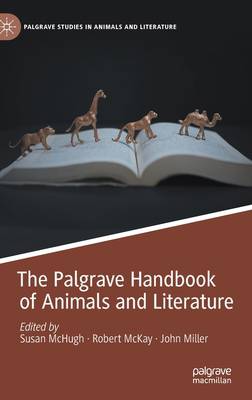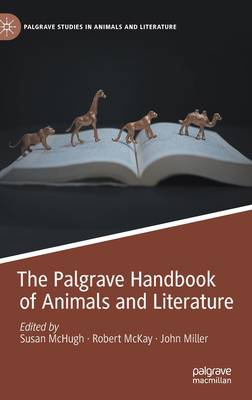
- Retrait gratuit dans votre magasin Club
- 7.000.000 titres dans notre catalogue
- Payer en toute sécurité
- Toujours un magasin près de chez vous
- Retrait gratuit dans votre magasin Club
- 7.000.0000 titres dans notre catalogue
- Payer en toute sécurité
- Toujours un magasin près de chez vous
The Palgrave Handbook of Animals and Literature
179,45 €
+ 358 points
Description
1. Introduction: Towards and Animal-centred Literary History; Susan McHugh, Robert McKay and John Miller.- 2. The Exception and the Norm: Dimensions of Anthropocentrism; Tom Tyler.- 3. Metaphor, Metonymy, More-than-Anthropocentric. The Animal that therefore I Read (and Follow); Ann-Sofie Lönngren.- 4. Narratology beyond the Human: Self-Narratives and Inter-Species Identities; David Herman.- 5. An(im)alogical Thinking: Contemporary Black Literature and the Dreaded Comparison; Diana Leong.- 6. We Are not in this World Alone: On Drawing Close, Animal Stories, and a Multispecies Sense of Place; Nandini Thiyagarajan.- 7. A Community of Exiles: Whale and Human Domains in Old English Poetry; Megan Cavell.- 8. An Ontological Turn for the Medieval Books of Beasts: Environmental Theory from Premodern to Postmodern; Susan Crane.- 9. Chaucer, Lydgate, and the Half-Heard Nightingale; Carolynn Van Dyke.- 10. Huntings of the Hare: The Medieval and Early Modern Poetry of Imperilled Animals; Karl Steel.- 11. Human, Animal, and Metamorphic Becomings; Carla Freccero.- 12. Sheep, Beasts, and Knights: Fugitive Alterity in Edmund Spenser's The Faerie Queene Book VI, and The Shepheardes Calender; Rachel Stenner.- 13. My Palfrey, Myself: Toward a Queer Phenomenology of the Horse-Human Bond in Henry V and Beyond; Karen Raber.- 14. What Can Beast Fables Do in Literary Animal Studies? Ben Jonson's Volpone and the Prehumanist Human; Erica Fudge.- 15. "Real" Animals and the Eighteenth-Century Literary Imagination; Laura Brown.- 16. Mary Leapor's Creatureliness in "An Essay on Woman" and Other Poems; Anne Milne.- 17. Poetics of the Hunt: Re-reading Agency and Re-thinking Ecology in William Somerville's The Chase; Richard Nash.- 18. Beyond Symbolism: The Rights and Biopolitics of Romantic Period Animals; Ron Broglio.- 19. Bad Dog: The Dark Side of Misbehaving Animals; Chase Pielak.- 20. Why Animals Matter in Jane Austen; Barbara Seeber.- 21. John Keats and the Sound of Nature: Reading Poetry in a Time of Extinction; Michael Malay.- 22. Cooper's Animal Offences: The Confusion of Species in Last of the Mohicans; Onno Oerlemans.- 23. Jane Eyre and Tess Durbeyfield at the Human/Animal Border; Ivan Kreilkamp.- 24. Animals and Nonsense: Edward Lear's Menagerie; Ann Colley.- 25. Intimacy, Objectification, and Inter/Intra-Species Relations in Victorian Animal Autobiographies; Monica Flegel.- 26. How Not to Eat: Vegetarian Polemics in Victorian India; Parama Roy.- 27. Modernist Animals and Bioaesthetics; Carrie Rohman.- 28. Vivisection in Modernist Culture and Popular Fiction, 1890-1945; Katherine Ebury.- 29. Virginia Woolf and Gertrude Stein: Two Modernist Women Writing as Dogs; Marianne Dekoven.- 30. Kingship, Kinship and the King of Beasts in Early Southern African Novels; Jade Munslow Ong.- 31. Animals Inside: Creatureliness in Dezső Kosztolányi's Skylark and Hanya Yanagihara's A Little Life; Anat Pick.- 32. Speculative Humanisms: Postwar Universalism and the Question of the Animal; Seán McCorry.- 33. CanLit's Ossiferous Fictions: Animal Bones and Fossils in Margaret Atwood's Life Before Man and Carol Shields's The Stone Diaries; Sarah Bezan.- 34. Returning to the Animals' Gaze: Reflective Readings of Lionesses Marah and Sekhmet; Wendy Woodward.- 35. "Without the right words it's hard to retain clarity" Speculative Fiction and Animal Narrative; Sherryl Vint.- 36. Jesmyn Ward's Dog Bite: Mississippi Love and Death Stories; Bénédicte Boisseron.- 37. Shared and Hefted Lives in Twenty-First Century Shepherds' Calendars; Catherine Parry.- 38. The Biopolitics of Animal Love: Two Settler Stories; Nicole Shukin.- 39. Companion Prosthetics: Avatars of Animality and Disability; Michael Lundblad and
Spécifications
Parties prenantes
- Editeur:
Contenu
- Nombre de pages :
- 636
- Langue:
- Anglais
- Collection :
Caractéristiques
- EAN:
- 9783030397722
- Date de parution :
- 26-11-20
- Format:
- Livre relié
- Format numérique:
- Genaaid
- Dimensions :
- 156 mm x 234 mm
- Poids :
- 1097 g

Les avis
Nous publions uniquement les avis qui respectent les conditions requises. Consultez nos conditions pour les avis.





